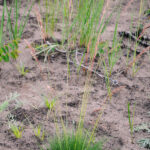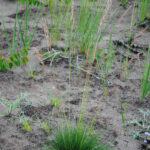Rocky Mountain / Alpine Fescue
Festuca saximontana / Festuca brachyphylla
General Description
Rocky Mountain fescue is a densely tufted, low-growing, perennial bunchgrass with dense fibrous roots. Alpine fescue is very similar in growth habit but slightly shorter in stature. Both are cool season native grasses. There has been some variety development research in the last 10 years by Alberta Research Council researchers in Vegreville, Alberta.
Type
Native grass.
Origin
Western North America.
Longevity
Long-lived.
Use
Reclamation, grazing. Used in reclamation mixes as a pioneer species in harsh environments. Also used for erosions control and for restoring Rocky Mountain sheep habitat. Also appropriate for grassland restoration.
Optimal Time of Use
Early spring and early summer, but also late fall.
Recovery After Use
Where Rocky Mountain fescue is a co-dominant in late successional grasslands, in the Interior Douglas-fir zone it decreases with overgrazing. At higher elevations, Rocky Mountain fescue and Alpine fescue can remain in mid-successional grazed alpine plant communities.
Less palatable than Idaho fescue and low forage production but important forage for wildlife. Stays green until late fall. Has also been reported to be fairly good forage for livestock.
Palatability/Nutritional Value
Palatability is low but an important source of food for Rocky Mountain sheep and for elk in spring and summer.
Annual Precipitation min/max (mm)
350mm / 700mm
Drought Tolerance
Both are drought tolerant and are noticeably absent from wetter areas.
Flooding Tolerance
Low tolerance.
Winter Hardiness
High tolerance
Soil Texture Preference
Prefers well drained sandy to loam soils.
Erosion Control
The fibrous roots of these grasses and their adaptation to sandy, gravelly, infertile soils make them useful for erosion control and rehabilitation of disturbed sites.
Salinity Tolerance
No to low tolerance.
Acidity Tolerance
Low to moderate tolerance.
Alkalinity Tolerance
Unknown.
Seeds per kg
1,041,000 seeds/kg (472,190 seeds/lb)
Suggested Mixtures
Best blended with junegrass, alpine bluegrass, or other native species.
Ease of Establishment
Germinates better in cooler soils. Use narrow spacing if drill seeding. Seed early in spring. Suggested seeding depth is 0.6 to 1.2 cm (1/4 to 1/2 in).
Competitiveness
Rocky Mountain fescue has low competitiveness which lends itself to be most compatible with other native species.
Management Considerations
Clear site of all weeds prior to seeding, as these species are not overly competitive.
BC Rangeland Seeding Manual, USDA Plants Database
Rocky Mountain fescue is found in some of the native grassland communities in the Interior-Douglas-fir zone in southern part of the Central Interior region. Alpine fescue is not adapted to the zones identified for the Central Interior region.
Rocky Mountain fescue is common, but not tyically dominant in the native grassland communities in Interior-Douglas-fir zone. Alpine fescue is not adapted to the Bunchgrass, Ponderosa Pine, Interior Douglas-fir and Interior-Cedar-Hemlock zones.
Rocky Mountain fescue is found on drier rocky slopes and ridges at higher elevation in the Peace-Liard region (Boreal White and Black Spruce zone), but it is less common than in the BC interior regions.

